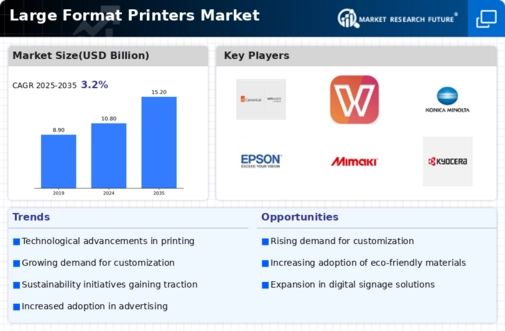Rise of E-commerce
The Global Large Format Printers Market Industry is experiencing a surge in demand due to the rise of e-commerce. As online retail continues to grow, businesses are seeking innovative ways to enhance their packaging and promotional materials. Large format printers enable e-commerce companies to create eye-catching graphics and customized packaging that resonate with consumers. This trend is particularly pronounced in sectors such as fashion and electronics, where branding plays a pivotal role. The market's expansion is indicative of the need for high-quality printing solutions that cater to the unique requirements of the e-commerce landscape.
Market Growth Projections
The Global Large Format Printers Market Industry is projected to experience substantial growth over the next decade. With a market value of 10.8 USD Billion in 2024, it is anticipated to reach 15.2 USD Billion by 2035, reflecting a compound annual growth rate (CAGR) of 3.22% from 2025 to 2035. This growth trajectory is indicative of the increasing adoption of large format printing across various sectors, including advertising, packaging, and textiles. The demand for high-quality, customized printing solutions is driving innovation and investment in the industry, positioning it for a robust future.
Sustainability Initiatives
The Global Large Format Printers Market Industry is increasingly influenced by sustainability initiatives. As environmental concerns grow, businesses are seeking eco-friendly printing solutions that minimize waste and reduce carbon footprints. Large format printers that utilize water-based inks and recyclable materials are gaining popularity among environmentally conscious consumers. This shift towards sustainable practices is not only beneficial for the planet but also aligns with consumer preferences for green products. The market is likely to see continued growth as companies adopt sustainable printing technologies to meet regulatory requirements and consumer expectations.
Technological Advancements
The Global Large Format Printers Market Industry is experiencing rapid technological advancements that enhance printing quality and efficiency. Innovations such as eco-solvent inks, UV printing technology, and advanced print heads are transforming the capabilities of large format printers. These advancements not only improve color accuracy and durability but also reduce production time and costs. For instance, the introduction of hybrid printers that can handle both rigid and flexible substrates is gaining traction. As a result, the market is projected to reach 10.8 USD Billion in 2024, driven by the demand for high-quality prints in various sectors, including advertising and textiles.
Growing Demand in Advertising
The Global Large Format Printers Market Industry is significantly influenced by the increasing demand for large format printing in the advertising sector. Businesses are increasingly utilizing large format prints for banners, billboards, and promotional materials to capture consumer attention. This trend is supported by the rising investment in outdoor advertising, which is expected to grow as companies seek to enhance brand visibility. The market is projected to expand, with a forecasted value of 15.2 USD Billion by 2035. This growth is indicative of the essential role that large format printers play in creating impactful visual communications.
Expansion of the Packaging Industry
The Global Large Format Printers Market Industry is also benefiting from the expansion of the packaging sector. As consumer preferences shift towards personalized and sustainable packaging solutions, large format printers are increasingly utilized to produce high-quality packaging materials. This trend is particularly evident in the food and beverage industry, where attractive packaging is crucial for product differentiation. The market's growth is further supported by the anticipated compound annual growth rate (CAGR) of 3.22% from 2025 to 2035. This growth reflects the increasing reliance on large format printing technologies to meet the evolving demands of packaging.






















